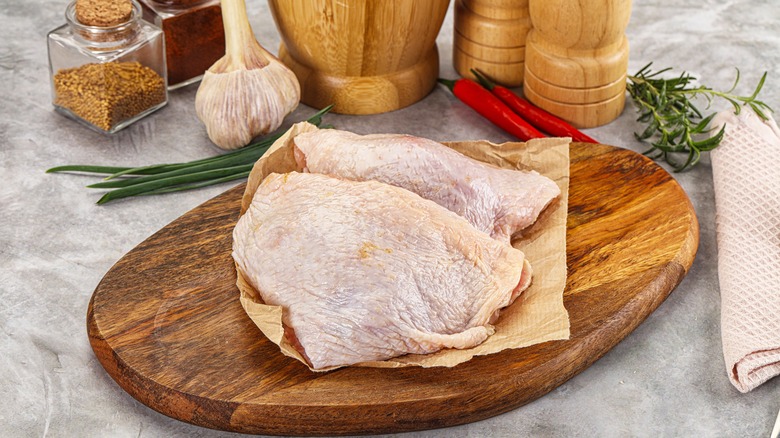Dry-Brine Your Chicken Thighs For The Best Crispy Skin
We may receive a commission on purchases made from links.
Baked, skin-on, bone-in chicken thighs are a marvel for dinner. Since the dark meat is so much tastier than white, it's no wonder Americans are starting to realize the superiority of dark meat chicken (though white meat remains healthier). The skin is also a delicious treat, but have you ever tasted it after dry-brining? It gets incredibly crispy, so crackly and crunchy; and while the texture is incredibly good, the flavor will have you looking longingly at the baking tray as you contemplate going back for seconds.
Dry-brining your chicken thighs (which involves rubbing the thighs all over with either salt or your seasoning choice, including salt, then placing on a baking tray, uncovered, in the fridge for up to 24 hours) draws moisture from the skin, bringing it to the surface, where it then evaporates into the cold refrigerator air. This much-less-moist skin, then, can get extra crispy in the oven.
It also bears mentioning that you should likely use more salt than however much you were planning to. A good rule of thumb is about 1 teaspoon per pound of chicken, though you can use more if you think that stretches the salt a bit thin (and you can always experiment with adding more salt on subsequent batches).
More tips for getting extra crispy chicken thigh skin
You'd be doing your chicken thighs a disservice if you went through the long dry-brine process, only to pop them in the oven at too low a temperature or without raising them from the cooking surface. Dry-brining is incredibly effective, but you can also help along the process while cooking by blasting the chicken with heat — no less than 400 degrees Fahrenheit. You can also use the convection setting on your oven, if you have it. Whatever temp you opt for, know that chicken thigh meat is very forgiving anyway, and dry-brining actually helps it maintain tenderness when cooking.
It would also behoove you to bake your chicken thighs on a wire rack over your baking tray. Elevating them ensures that the hot air can get all around each piece, and it lessens the contact any bit of the skin might have with the bottom of the tray, which can lead to grease build-up.

